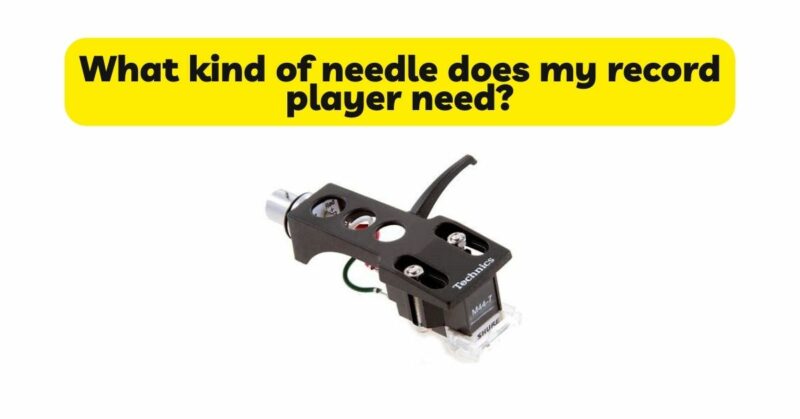When it comes to getting the best performance from your record player, choosing the right needle, or stylus, is crucial. The needle plays a vital role in accurately tracking the grooves of your vinyl records and converting the physical vibrations into electrical signals. However, determining the specific needle type your record player requires can be a challenge, given the multitude of options available. In this article, we will delve into the factors that influence the needle requirements of your record player, helping you navigate through the various types and make an informed decision to optimize your listening experience.
- Identify Your Turntable Model: The first step in understanding the needle requirements of your record player is to identify the make and model of your turntable. This information can usually be found on the turntable itself, in the user manual, or on the manufacturer’s website. By knowing the model, you can narrow down the search for the appropriate needle type.
- Consult the Manufacturer’s Documentation: The manufacturer’s documentation, including the user manual or product specifications, is a valuable resource for understanding the needle requirements of your record player. Manufacturers often provide detailed information about compatible needle types, specifications, and recommended replacements. Refer to the documentation provided with your turntable to ensure accurate needle selection.
- Determine the Cartridge Type: The cartridge is the component of your turntable that houses the needle. Different turntables use different cartridge types, including moving magnet (MM) and moving coil (MC) cartridges. Each cartridge type has its own needle requirements. Determine the cartridge type of your turntable to understand the corresponding needle type it needs.
- Evaluate the Mounting Type: The mounting type refers to how the cartridge is attached to the tonearm of your turntable. There are two common mounting types: standard mount and P-mount (T4P). Standard mount cartridges are secured with screws, while P-mount cartridges have a standardized plug-and-play design. Identifying the mounting type of your cartridge is crucial for selecting the appropriate needle.
- Understand the Needle Shape: Needles come in various shapes, including conical, elliptical, microline, and line contact. Each shape has its own impact on sound quality, tracking ability, and record wear. Conical needles have a rounded tip and are suitable for general playback. Elliptical needles have a more precise shape, resulting in better tracking and sound reproduction. Microline and line contact needles offer even greater detail retrieval and reduced distortion. Consider your sound quality preferences and the condition of your records to determine the most suitable needle shape for your needs.
- Consider Record Compatibility: Different records have varying groove characteristics, and certain needle types are designed specifically for specific record types. For example, 78 RPM records require specialized needles due to their wider grooves. Ensure that the needle you choose is compatible with the records you plan to play on your turntable to achieve optimal performance and sound quality.
- Evaluate Your Budget and Listening Goals: Budget considerations and your listening goals play a significant role in selecting the appropriate needle for your record player. Needles are available in a wide price range, and higher-quality needles often offer improved sound reproduction and durability. Determine your budget and prioritize your listening goals to strike the right balance between cost and performance.
- Seek Expert Advice: If you are uncertain about the specific needle requirements of your record player or need assistance in making a decision, seek advice from turntable manufacturers, authorized dealers, or audio experts. They possess the knowledge and expertise to guide you through the selection process and offer personalized recommendations based on your turntable model, cartridge type, and listening preferences.
- Consider Upgrades and Customization: Some turntables allow for needle upgrades and customization to enhance sound quality and cater to individual preferences. Upgrading your cartridge and needle combination can significantly improve performance. However, ensure compatibility between the upgraded components and your turntable’s specifications before making any modifications.
- Trial and Adjustment: Once you have identified the appropriate needle type for your record player, it may require some trial and adjustment to achieve the best sound quality and tracking performance. Fine-tuning the alignment, tracking force, and anti-skate settings can further optimize the performance of your chosen needle. Experimentation and adjustment may be necessary to find the sweet spot for your specific setup.
Conclusion: Understanding the needle requirements of your record player is essential for achieving optimal sound quality, accurate tracking, and preserving your precious vinyl records. By identifying your turntable model, consulting the manufacturer’s documentation, determining the cartridge type and mounting style, considering the needle shape and record compatibility, evaluating your budget and listening goals, seeking expert advice, and considering upgrades and customization, you can confidently select the right needle for your record player. Remember that the appropriate needle choice may require trial and adjustment to fine-tune the performance. With the right needle in place, you can unlock the full potential of your record player and embark on a captivating musical journey.


